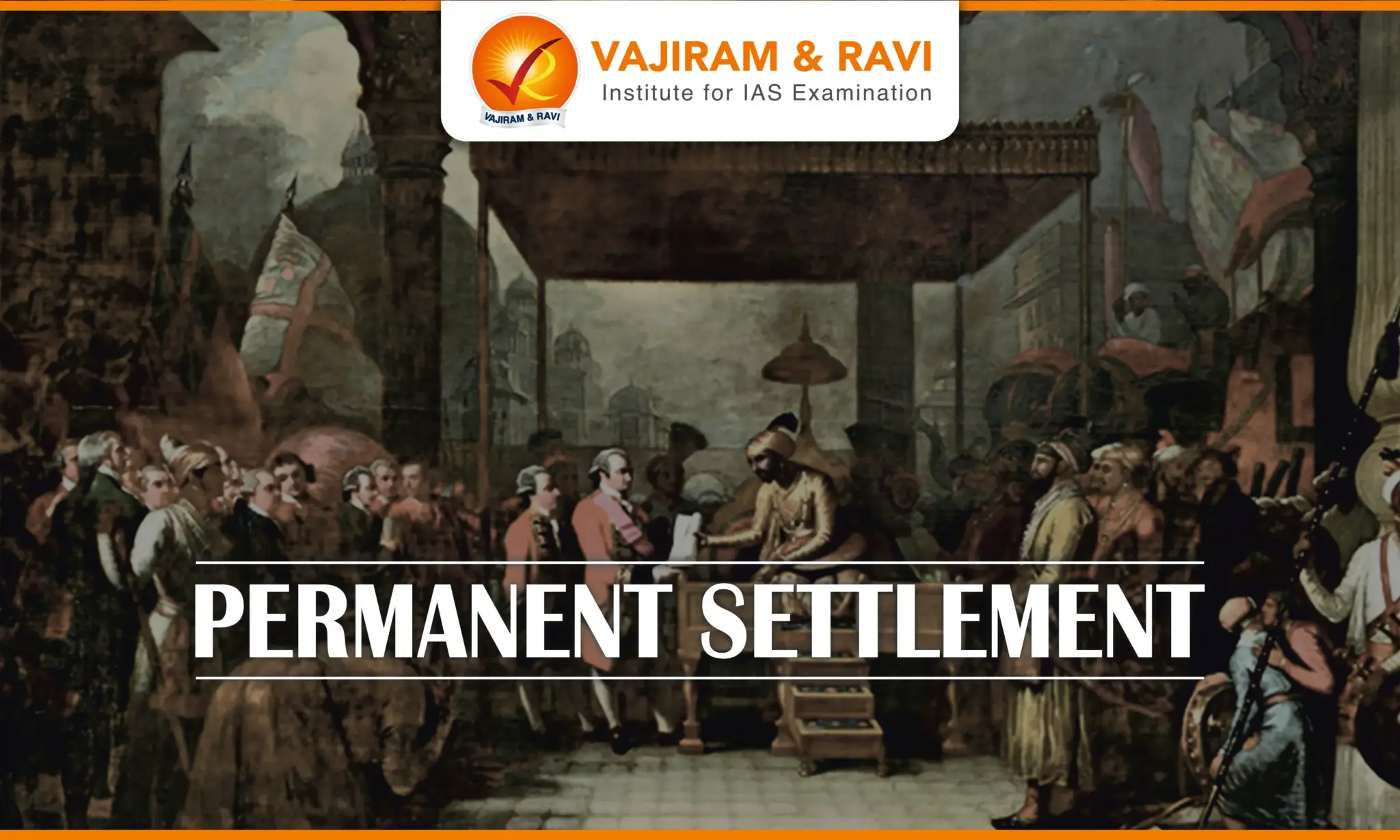The Permanent Settlement, also known as the Permanent Settlement of Bengal or Zamindari System, was a land revenue system introduced by the British East India Company in 1793 under the administration of Governor-General Lord Cornwallis. This system marked a significant shift in the administration of land revenue in India, particularly in Bengal, Bihar, and Orissa.
The Permanent Settlement aimed to stabilise revenue by granting Zamindars hereditary land rights in exchange for a fixed tax payment to the British government. The Permanent Settlement had far-reaching consequences, both positive and negative, and played a crucial role in shaping the socio-economic landscape of colonial India.
Permanent Settlement Background
The Permanent Settlement was implemented in response to administrative challenges faced by the British East India Company after it gained control over Bengal following the Battle of Buxar in 1764. Before British rule, zamindars collected revenue on behalf of the Mughal Empire through systems such as the Diwani System.
However, the Company struggled to manage revenue collection efficiently and faced issues such as corruption and lack of oversight, leading to economic distress and famines, notably the Bengal famine of 1770.
- Proposal: In 1776, Philip Francis proposed a permanent land revenue settlement. Lord Cornwallis, sent as governor-general, was instructed to make it permanent with the zamindars.
- Formation of Committee: Cornwallis, along with Sir John Shore and James Grant, formed a committee to investigate. Cornwallis, from Britain’s landed aristocracy, favoured granting zamindars ownership rights to encourage land improvement, like English landlords.
- The rationale for Settlement: With many cultivators, collecting revenue from fewer zamindars was seen as simpler, leading all land under the permanent settlement to be part of a zamindari.
- Areas Covered: The system covered about 19% of British-ruled territory, starting in Bengal and Bihar, and expanding to Orissa, Banaras, and northern Madras.
Permanent Settlement Features
The Permanent Settlement introduced several features that redefined land ownership and revenue collection in colonial India. Some of the important features of the Permanent Settlement included:
- Fixed Land Tax: In 1790, a ten-year tax agreement was established with the Zamindars, and by 1793, this arrangement was made permanent.
- The Zamindars were required to pay a fixed tax on their land, which they collected from the cultivators, now considered tenants (ryots or raiyyats).
- Revenue Sharing: The Permanent Settlement fixed the land revenue that Zamindars had to pay to the Company permanently.
- This amount was set at 10/11 of the revenue, with the zamindars keeping the remaining 1/10th.
- Land Ownership Rights: As landowners, Zamindars had the right to sell, mortgage, or transfer their land. Their heirs could inherit both the land and the associated rights and liabilities.
- However, under the ‘sunset clause’ introduced in 1794, if the tax were not paid by sunset on a specified date, the Zamindari would be confiscated by the government and auctioned off, transferring ownership rights to the highest bidder.
- Tenant Control: Regulations enacted in 1793, 1799, and 1812 empowered Zamindars to seize the property of tenants who failed to pay rent without needing approval from any court of law.
- Limited Government Intervention: The British government adopted a policy of non-intervention in the relationship between Zamindars and the peasants.
- Patta System: Zamindars were required to issue pattas (lease agreements) to tenants, detailing the land area and rent to be paid.
- Geographical Extent: The Permanent Settlement was primarily implemented in Bengal, Bihar, and Orissa. It was later extended to some parts of northern Madras and the Varanasi region.
- However, this system was not applied uniformly across all British territories in India.
Permanent Settlement Merits
The Permanent Settlement had several merits. It provided a stable revenue system for the British while incentivising Zamindars to invest in land improvements, thereby promoting agricultural productivity.
- Effective Administration: Zamindars, being locals, were better positioned to manage agricultural activities and understand local customs, potentially leading to more effective governance.
- Stable Revenue Source: The Permanent Settlement provided the British government with a stable and predictable source of revenue, which was crucial for funding their administration and military in India.
- Sense of Security: The Permanent Settlement system’s fixed nature provided security for all parties— the British had revenue certainty, landlords knew their collections, and farmers, with the patta, were assured of their landholdings and rent obligations.
- Investment Incentives: By granting zamindars ownership rights, the permanent settlement encouraged them to invest in land improvements, which theoretically increased agricultural productivity.
Permanent Settlement Demerits
The Permanent Settlement, while stabilising British revenue collection, had significant drawbacks, leading to widespread peasant exploitation and land management issues.
- Absentee Landlordism: High revenue rates left many Zamindars unable to absorb losses from disasters, leading to the sale of numerous estates. This increased absentee landlordism as merchants, officials, and other Zamindars bought these lands.
- Subinfeudation of Land: To meet high revenue demands, Zamindars subdivided their estates into smaller plots (patni taluq) and leased them permanently to tenants (patnidars) for fixed rent, marking the rise of subinfeudation.
- Exploitation of Peasants: Though Zamindars were required to issue written rent agreements (pattas), they rarely did, allowing them to exploit peasants by demanding higher rents, pushing them into debt and serfdom.
- Neglect of Land Improvements: The Zamindars focused solely on extracting rent and made no efforts to improve the land or agricultural practices.
- No Scope for Change: From the government’s perspective, the fixed revenue meant there was no way to increase taxes, leaving the British East India Company unable to raise additional funds to cover the growing costs of its wars and expansion efforts.
Permanent Settlement Impacts
The Permanent Settlement had profound effects on the socio-economic landscape of colonial India, deeply affecting farmers, Zamindars and the Company.
- Impact on Farmers: The Permanent Settlement had significant repercussions for farmers, who found the system to be oppressive and exploitative.
- They were required to pay high rents to the Zamindars, even though the Zamindars’ ownership of the land was often uncertain.
- To meet these steep rent demands, farmers frequently had to take out loans, and failure to pay would result in their eviction from the land.
- Impact on Zamindars: The fixed revenue demand was set at a level that was often difficult to meet for the Zamindars.
- Those who could not pay the required revenue lost their Zamindaris.
- This financial pressure discouraged Zamindars from investing in land improvements; instead, they were more interested in simply renting out the land to collect income.
- Impact on Company: The Permanent Settlement provided some initial benefits to the British East India Company. It ensured that the company received regular income.
- During the first decade of the 19th century, agricultural cultivation expanded, and market prices increased, leading to higher incomes for the Zamindars.
- However, the Company faced a financial setback because it was unable to raise revenue, as it had agreed to the fixed, permanent rate.
Permanent Settlement UPSC PYQs
Question 1: The tendency for increased litigation was visible after the introduction of the land settlement system of Lord Cornwallis in 1793. The reason for this is normally traced to which of the following provisions? (UPSC Prelims 2011)
(a) Making Zamindar’s position stronger vis-a-vis the ryot.
(b) Making East India Company an overlord of Zamindars.
(c) Making the judicial system more efficient.
(d) None of the (a), (b) and (c) above.
Ans: (d)
Last updated on April, 2025
→ UPSC Notification 2025 was released on 22nd January 2025.
→ The UPSC Vacancy 2025 were released 1129, out of which 979 were for UPSC CSE and remaining 150 are for UPSC IFoS.
→ UPSC Admit Card 2025 is expected to release in first week of May for CSE Prelims Exam 2025.
→ The UPSC Prelims 2025 is scheduled to be conducted on 25th May 2025 and UPSC Mains 2025 will be conducted on 22nd August 2025.
→ Apply once through it and aspirants can apply for various government exams conducted by UPSC.
→ The UPSC Selection Process is of 3 stages-Prelims, Mains and Interview.
→ UPSC Result 2024 is released with latest UPSC Marksheet 2024. Check Now!
→ UPSC Toppers List 2024 is released now. Shakti Dubey is UPSC AIR 1 2024 Topper.
→ Also check Best IAS Coaching in Delhi
Permanent Settlement FAQs
Q1. What do you mean by Permanent Settlement?+
Q2. Who introduced the Permanent Settlement system?+
Q3. What was the second name of Permanent Settlement?+
Q4. What are the main features of a Permanent Settlement system?+
Q5. What are the problems of Permanent Settlement?+
Tags: permanent settlement quest















